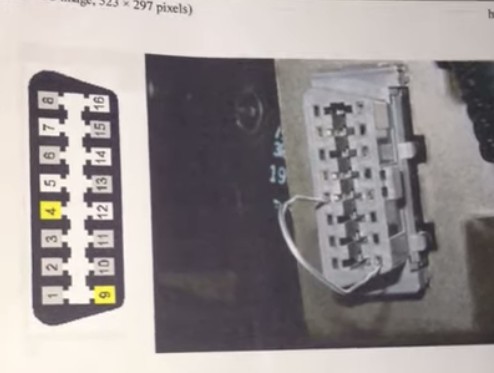Accidentally bridging connections in your car’s On-Board Diagnostics II (OBD2) port can lead to unexpected electrical issues. One Honda Element owner learned this the hard way while attempting a DIY diagnostic procedure. Intending to read transmission codes by jumping specific pins in the OBD2 port, a common technique for older vehicles, they mistakenly connected the wrong pins. This misstep resulted in a cascade of electrical problems, leaving several car accessories powerless. This article explores the potential consequences of incorrect OBD2 port jumpering and provides a troubleshooting guide if you find yourself in a similar situation.
The Mistake: Incorrect OBD2 Port Jumpering
The owner of a 2008 Honda Element with a blinking “D” transmission indicator sought to diagnose the issue using a paperclip or jumper wire to retrieve diagnostic trouble codes. Online forums suggested connecting pins 4 and 9 on the OBD2 port to access these codes. However, in an unfortunate mix-up, they inadvertently jumpered pins 5 and 16.
Pin 16 of the OBD2 port is designated for battery voltage (+12V), while pin 5 is a signal ground. Bridging these two pins creates a direct short circuit, potentially causing damage to electrical circuits and components.
 OBD2 Port Pinout Diagram for Correct Jumpering
OBD2 Port Pinout Diagram for Correct Jumpering
Correct OBD2 port pin configuration highlighting pin 4 and 9 for diagnostic jumpering, contrasting with the mistakenly shorted pins 5 and 16.
While the intended jumper between pins 4 and 9 is a safe procedure for retrieving certain diagnostic codes in some vehicles, shorting pin 16 to ground is a critical error that can lead to electrical malfunctions. Referencing an OBD2 pinout guide like pinoutguide.com is crucial before attempting any DIY OBD2 port manipulations.
Symptoms of OBD2 Port Short Circuit
After realizing the mistake and correctly jumping pins 4 and 9 to successfully read the transmission code, the Honda Element owner discovered a range of electrical accessories were no longer functioning correctly. The issues included:
- Non-functional Radio: The car radio ceased to power on.
- Dome Light Malfunction: The dome light only worked when the ignition key was in the “ON” position, unlike its normal operation.
- Power Lock Problems:
- With the key “ON,” the unlock button worked, but the lock button did not.
- Manually pushing the lock knob on the driver’s door locked all doors, but only when the key was “ON.”
- With the key “OFF,” power lock buttons were unresponsive.
- Remote Key Fob Inoperable: The key fob’s lock, unlock, and other functions stopped working.
- Cruise Control Button Disabled: The cruise control on/off button near the driver’s knee failed to illuminate, indicating it was not receiving power.
- OBD2 Port Inactive: The OBD2 port itself stopped working with a scanner, and pin 16, normally providing 12V power, was dead.
Interestingly, some electrical systems remained operational, such as external lights, turn signals, backup lights, the rear hatch dome light, the passenger dash 12V accessory socket, power windows, and power mirrors. This selective loss of function points towards specific fuses or circuits being affected by the short circuit.
Troubleshooting Steps: Checking Fuses and Beyond
The first and most logical step in troubleshooting electrical issues after an OBD2 port mishap is to check the car’s fuses. The owner in this scenario reported checking fuses but finding none blown. However, it’s crucial to double-check all relevant fuses, particularly those associated with the affected accessories and the OBD2 system.
Consult your Honda Element owner’s manual for fuse box locations and diagrams. Focus on fuses related to:
- Radio/Audio System
- Interior Lights/Dome Light
- Power Door Locks
- Remote Keyless Entry System
- Cruise Control
- OBD2 System/Diagnostic Port
- Accessory Power/ACC
Even if a fuse visually appears intact, it’s advisable to test it with a multimeter or replace it with a known good fuse to rule out a blown fuse that is not easily detectable.
If all relevant fuses are confirmed to be good, the problem might lie deeper within the electrical system. Potential issues could include:
- Relays: A short circuit could damage relays associated with the affected circuits.
- Wiring: Damage to wiring harnesses or individual wires near the OBD2 port or within the affected accessory circuits is possible.
- Control Modules: In more severe cases, a short circuit could potentially damage electronic control modules that manage accessory power or body control functions.
For in-depth troubleshooting beyond fuses, accessing a Honda Element wiring diagram specific to the 2008 model year is highly recommended. This will allow for tracing the circuits and pinpointing the location of the electrical fault.
If you are not comfortable working with automotive electrical systems or cannot locate the source of the problem after checking fuses, it is best to seek assistance from a qualified automotive electrician or a Honda service center. Incorrectly jumping an OBD2 port can have consequences, but with systematic troubleshooting, the electrical gremlins can usually be identified and resolved.